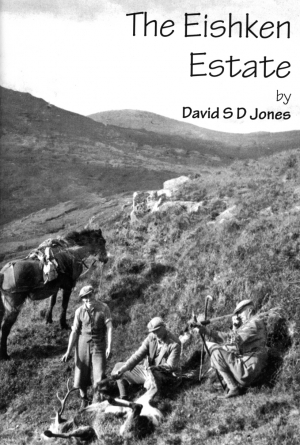NEW BOOKLET ON EISHKEN ESTATE LAUNCHED IN ORINSAY
An impressive illustrated new publication about the history of the Eishken estate in Pairc, Lewis, written by well-known historian David Jones, was launched by Comunn Eachdraidh na Pairc at Orinsay Village Hall recently.
The huge extent of the peninsula of Pairc, which but for a narrow neck of land between the heads of Loch Erisort and Loch Seaforth would be an island, together with its remoteness from main population centres, and dramatic mountain and coastal scenery, have always marked it out as special. There is now growing evidence that Pairc was the private deer park of the owners of Lewis from an early date, a fact which almost certainly explains its name. The population of this vast area was probably relatively sparse up to the late 18th century when kelp and fishing began to take on greater economic importance and led to landlords encouraging local populations around the coastal fringes, perhaps for the first time. But the collapse of the kelp industry in the 19th century, together with the high rents available for a time from sheep farming, followed by the fashionable interest in deer forests during the Victorian period, transformed the position as people once again became expendable.
In this booklet, David Jones describes how successive owners and sporting tenants developed Eishken into one of the great sporting estates. It became famous for its hunting and fishing resources, attracting many well-known sportsmen (and indeed, in the case of Jessie Platt, at least one woman). Unlike all of the other Lewis sporting subjects developed by the Mathesons in the 19th century, which were managed and staffed by Lewis estate employees, Eishken was run on an autonomous basis by the lessees, Mr and Mrs Platt, from 1886 until 1925. Not only were the lessees responsible for employing gamekeepers, stalkers and other outdoor staff such as gillies, gardeners and labourers, but they built and maintained the shooting quarters, Eishken Lodge, at their own expense, laid out gardens, paid for a telegraph office to be installed in the nearby township of Balallan and constructed miles of stalking tracks throughout the deer forest.
From the solid foundations laid by Mr and Mrs Platt in the late Victorian period, the Eishken estate gradually evolved into one of the finest deer forests in Scotland over the past one hundred and twenty years or so, attracting many well known gentlemen stalkers from the elite of society, including cabinet ministers, captains of industry and noted physicians. In times past, the property was also noted for superlative grouse shooting, hare driving and otter hunting.
However, in addition to providing stalking, shooting and angling, facilities for generations of sportsmen, Eishken also played a crucial part in the Lewis land struggle. In 1887, the estate was the setting for the Park Deer Raid, a peaceful protest against the inequality of landownership in the Highlands and Islands, which sent shock waves throughout the Scottish landowning fraternity at the time. The raid is commemorated today by a memorial at the side of the Stornoway to Tarbert road near the Eishken roadhead and was one of a number of acts of protest which eventually led to the passage of the Land Reform (Scotland) Act of 2003, which enables crofting communities to purchase the estates on which they live and work.
The booklet, which includes many old and rare photographs, is available price £6 here from our web site shop or at the Ravenspoint Centre, Kershader, South Lochs (phone Margaret Macdonald on 01851 880737). Posted by cepaircadmin | 2 comments
